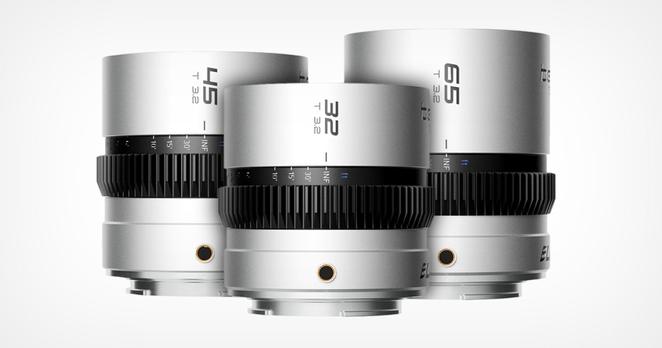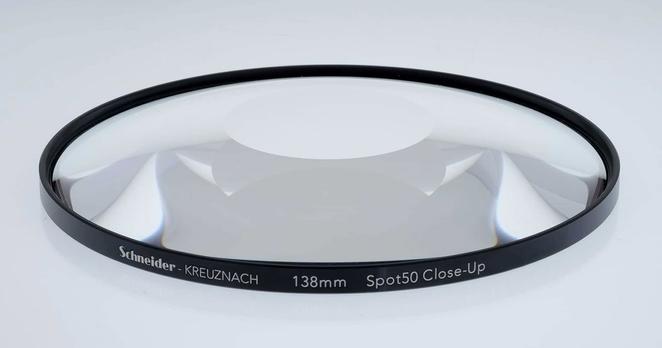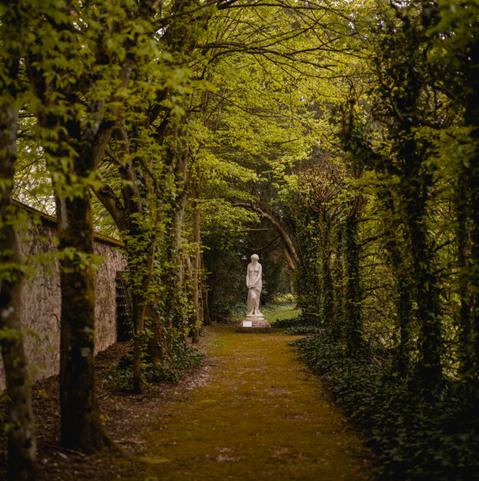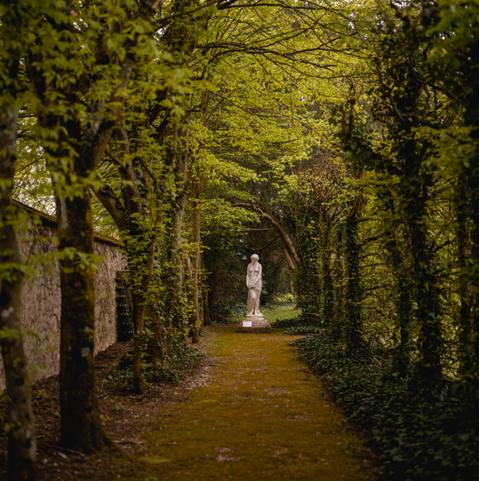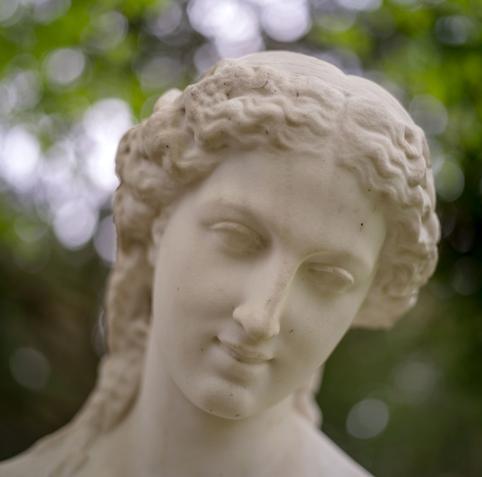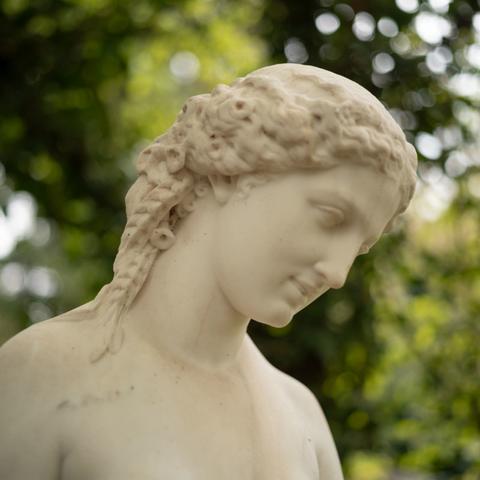Photographer Uses AI to Restore 110-Year-Old Photos, Bring Them to Life
Photographer and Youtuber Mathieu Stern recently purchased two glass plate negatives from 1910 and decided to scan, restore, colorize, and animate the photos with the help of artificial intelligence (AI).
Stern said that after he purchased the two negatives, he spent some time online studying Victorian glass plate archives so that he could try and learn more about the woman in the photo. What he found was that in the early days of photography, getting a portrait taken was expensive, stressful, and time-consuming. He says this is likely why photos of people from that time period look cold and emotionless.
In the video, Stern provides several examples of photos from the archive that illustrate this. What makes Stern's particular negatives different is that the woman depicted isn't alone: she's with a dog.
"While doing research, I discovered something amazing that changed people's faces," Stern says. "With pets in front of the lens, everything became different. A new emotion appeared: the happiness of being together."
Stern says that at the start of the 20th century, people started to rethink their relationship with animals and pets became viewed as members of the family, an emotional attachment that has continued to grow substantially to the point it is today. The presence of her dog might explain why the two photos Stern acquired feature a woman with a happy expression.
Because his particular negatives were damaged, Stern decided to restore the photos and colorize them to give them a breath of new life more than a century after they were taken.
"I started by cleaning the two plates in Photoshop CC using a mix of content-aware filling and healing brush tools," Mathieu tells PetaPixel.
"The face of the lady was not perfectly in focus on one of the plates, so I used an artificial intelligence neural network to enhance her facial features. Then I used another AI to auto colorize the plates, I also used the Neural filters in Photoshop CC to do the same job, but in both cases, the results were very far from perfect."
To fine-tune the edit, Stern colorized everything manually using references from similar modern images for both the woman and the dog.
"I used a lot of layers in 'color' fusion mode and spent a good amount of time working on the project," he says.
At the end of the video, Stern shows a quick facial animation using a mix of different AI programs that are available for free online. While he doesn't specify, the result is similar to the types of images created using "Deep Nostalgia," a tool that animates historical photos with startling accuracy.
"Thanks to new technologies, after 110 years, we can have a new vision of the past," Stern says.
For more from Mathieu Stern, subscribe to his YouTube Channel.
_Image credits: Photos provided courtesy of Mathieu Stern. _
#postprocessing #spotlight #adobe #adobephotoshop #ai #artificialintelligence #colorization #colorizedhistory #deepnostaliga #glassnegative #mathieustern #neuralfilters #restoration #victorianera
Try one of these seven weird and unusual lenses to shoot your next documentary
#gear #anamorphicadapter #anamorphiclens #mathieustern #weirdlenses
Try one of these seven weird and unusual lenses to shoot your next documentary
The king of weird lenses, Mathieu Stern set himself a challenge with a documentary short film he shot recently. The challenge was to use only anamorphic and swirly bokeh lenses. But he wasn’t just getting off-the-shelf ready-to-go lenses you can pick up online (although he did use a couple). He ended up using seven different […]
Unusual Adapter Places a Polarizing Filter Between Lens and Sensor
While originally launched in 2017, Fotodiox created a line of lens adapters for modern and vintage SLR lenses it calls Polar Throttle adapters that have a built-in polarizing filter. The design allows multiple lenses to be adapted to a single mirrorless camera without needing different sized filters.
The adapters have largely flown under the radar, but YouTuber Mathieu Stern recently featured one of the Polar Throttle adapters -- the Canon FD to E-mount version -- on his YouTube Channel. He demonstrates that the filters work exactly as a polarizing filter is expected to -- it removes reflections from bodies of water and when shooting through glass -- but allows him to use multiple Canon FD lenses on his Sony camera without having to use different sized polarizing filters. It also reduces his kit significantly as it compresses all the circular polarizers he might need to carry with him into just one adapter, which is necessary for using the vintage lenses on his Sony camera anyway.
"Since mirrorless cameras hit the scene, our mission has been to vastly expand customer's lens choices. With the Polar Throttle, we’ve found yet another way to deliver an important level of image control to the mix," Bohus Blahut, the marketing director for Fotodiox Pro, said when the adapters were launched in 2017. "You can't adjust light polarization in post, and fixing issues on-location used to mean lugging around many different-sized CPL filters. With the Polar Throttle, you get easy, reliable, built-in fingertip polarization control for any lens you attach. Cut down haze, manage reflections, create evocative long exposures in full daylight, and dial in richer, bolder colors whether you're shooting photo or video."
Stern shows multiple examples of how the circular polarizer works wonders on bodies of water, which can dramatically reduce reflections and reveal what is going on under the surface.
Before After
The adapter is available in a number of options for Sony E-mount cameras including Canon EOS, Canon FD, Nikon G, and Minolta MD and the polarizing adjustment ring is geared to allow for use on follow focus rigs in video production. Nine of the adapters are priced at $100, but one smart version that includes the circular polarizer and also features "Smart" adaptation between Canon EF and Sony E-mount is priced at $190. All options can be found on Fotodiox's website.
#equipment #news #adapter #circularpolarizer #circularpolarizingfilter #dslrlens #emount #filter #fotodiox #mathieustern #mirrorless #slrlens #sonyemount
This photographer 3D printed a 3D lens for mirrorless cameras
#gear #3dphotography #3dphotos #3dprinted #3dprinter #georgemoua #mathieustern #stereoscopic #stereoscopy
This photographer 3D printed a 3D lens for mirrorless cameras - DIY Photography
3D printing your lenses or lens hoods has been a thing for a while, and you can make some cool creations. Well, this 3D-printed 3D lens is definitely one of them. George Moua designed a 3D lens for a digital mirrorless camera, and in this video, Mathieu Stern put it to a test to show […]
This adapter lets you shoot medium format photos with a full-frame camera
#gear #fotodioxrhinocamvertex #fullframe #mathieustern #mediumformat
This adapter lets you shoot medium format photos with a full-frame camera - DIY Photography
You don’t need a medium format camera to shoot medium format photos anymore. Well, sort of. FotodioX RhinoCam Vertex adapter lets you shoot digital medium format photos with your full-frame camera. Mathieu Stern tried this $300 gadget, and it seems to do the trick pretty well. First things first, how does the RhinoCam Vertex work? […]
Full-Frame to Medium Format Adapter Produces Astounding Results
Photographer and YouTuber Mathieu Stern recently tested the Fotodiox Rhinocam Vertex, an adapter that claims to allow photographers to easily capture medium format images with a full-frame camera. Not only does it appear to work, but it is also more than that. It is, as he says, "a revolution."
Fotodiox originally pitched the adapter as excellent for landscapes and still life applications, as noted in the company's launch of the product:
“RhinoCam Vertex is ideal for landscape, commercial, and architectural photographers seeking remarkably high resolution at a fraction of the cost. The lens remains firmly in place while the RhinoCam Vertex’s moving platform positions the sensor for multiple precisely-positioned exposures. After the capture process, it takes seconds to merge the multiple exposures into one larger image using automated stitching functionality built into Adobe Photoshop.”
While objects that remain stationary are one thing, Stern wanted to see if it was a viable tool for portraiture. Additionally, it was important to him to see if the adapter successfully translated the depth of field and compression factor that comes with using medium format cameras and lenses.
Stern says that in the past he has used what he calls a "panorama method" to make images that look similar to medium format but found that he had issues with lenses that had swirly or unique bokeh and would often take a huge number of images in order to assure he had proper coverage to create a finished stitched image. While he does not call it out directly, this sounds like the Brenizer Method that was popular in the early 2010s as a way to create large, high-resolution, shallow depth of field images with a wide-angle.
"It's easy to lose track and shoot 50 photos to make sure you're not missing anything," Stern says. "But with the Rhinocam Vertex you are guided to create your image, and you only need four photos to create your full six by six medium format image."
In the example images below, Stern shows that the Vertex is successfully able to handle portraiture and operate with lenses that have a unique bokeh without issue, which adds to its value over using other unguided stitching methods.
There are some editing notes that should be taken into consideration when using the lens for portraiture, which Stern covers in the video above.
"My conclusion: this adapter lets you dramatic six by six medium format images that were previously reserved for photographers working with expensive medium format digital cameras. And for me, that is an open door for fantastic new possibilities," Stern says.
For more from Mathieu Stern, subscribe to his YouTube Channel or follow him on Instagram.
_Image credits: Photos by Mathieu Stern and used with permission. _
#equipment #adapter #canonrfmount #fotodiox #fullframe #lensadapter #mathieustern #mediumformat #mediumformatlenses #nikonzmount #rhinocam #rhinocamvertex #sonyemount #squareformat
